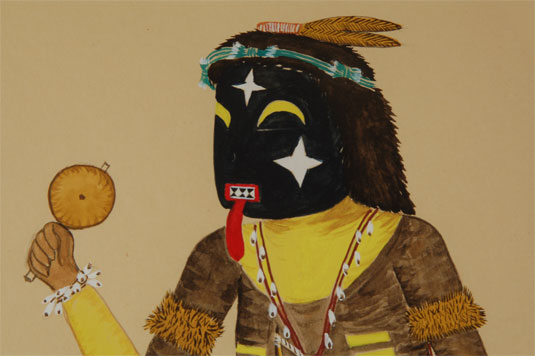Painting of Hopi Chakwaina Katsina [SOLD]
+ Add to my watchlist Forward to Friend
- Category: Paintings
- Origin: Hopi Pueblo, Hopituh Shi-nu-mu
- Medium: tempera
- Size:
12” x 16” image;
21” x 17” framed - Item # C3839i SOLD
It was never the intent of the Hopi to share their secrets with the White culture as there generally was a distrust by the Hopi of the White. The Hopi villages were thrust into turmoil in the early 20th century when the villages split among those who believed it was wise to follow the government’s orders to send their children to white man’s schools and those who were against. However, in the late 1950s Oswald White Bear Fredericks convinced Fredrick Howell, director of the Charles Ulrick and Josephine Bay Foundation, to underwrite a history of the Hopi people. Howell approved the idea and, eventually, Frank Waters was chosen as the writer to work with White Bear.
White Bear's role in the project was to record and transcribe oral histories gathered from Hopi elders. Frank Waters lived on the Hopi Reservation for three years while gathering information provided by Hopi elders and translated by White Bear. It is from this information that Frank Waters compiled his Book of the Hopi in 1963.
The book was popular, drawing interest from the public and Hopi alike. Within the book were the myths of the Hopi and general information on their clans and rituals. This book became quite popular with the alternative movements of the 1960s and led to many pilgrimages to Hopi, and even unwanted settlement. Today, the book still holds favor with the New Age crowd, stimulating pilgrimages to Hopi from all over the world, especially Germany.
The original 72 paintings and drawings by White Bear for Waters’ book are now in the Museum of the American Indian in Washington, D.C.
In his later years, White Bear continued his reputation as a top artist and as a teacher of Hopi culture. He shared his art and his knowledge with the world through public presentations in the United States and Europe. For many years, he could be found exploring the backcountry of Hopi and the Verde Valley in search of answers to Hopi prophecy. White Bear died on February 6, 1996.
Waters also wrote a book Pumpkin Seed Point describing almost daily events while living at Hopi during his research years. He lays out all the difficulties experienced during those years and his frustrations with some of the elders with whom he consulted.
This Chakwaina Katsina painted by White Bear is dated 1965, after the departure of Frank Waters from Hopi. On verso, White Bear wrote Cha Kwaina Warrior of South, Ahsa Clan Aztec (One who Cries). It is an excellent and accurate representation of this katsina. Chakwaina appears most often in January during the Kiva Dances—dancing in a line with rather lively gestures, stooping and turning and singing a spirited tune. Chakwaina Katsinas are warriors.
Condition: appears to be in original condition and has recently been framed with archival materials.
Provenance: from the collection of a resident of California who inherited her mother’s Native art collection
Reference: Book of the Hopi by Frank Waters and Oswald Fredericks

- Category: Paintings
- Origin: Hopi Pueblo, Hopituh Shi-nu-mu
- Medium: tempera
- Size:
12” x 16” image;
21” x 17” framed - Item # C3839i SOLD



